
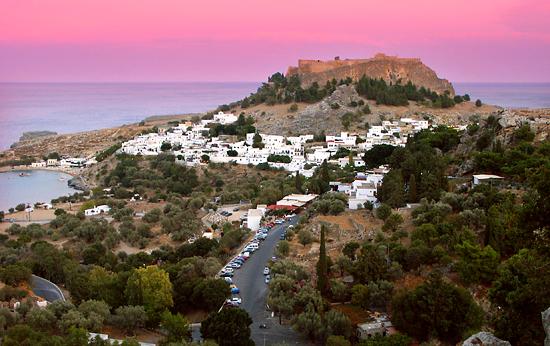
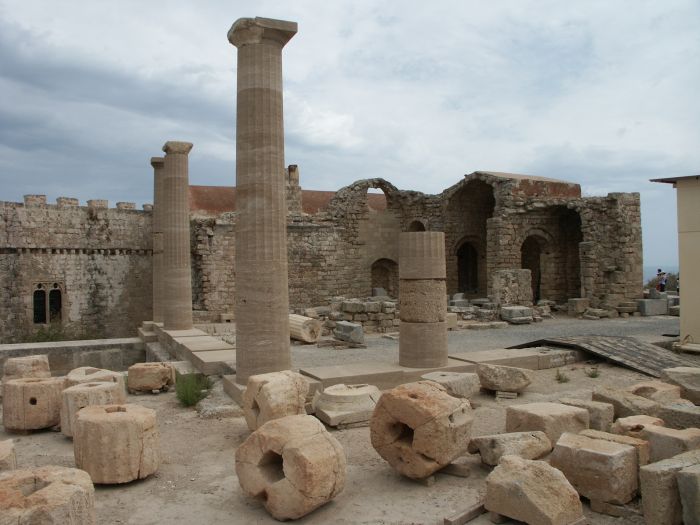
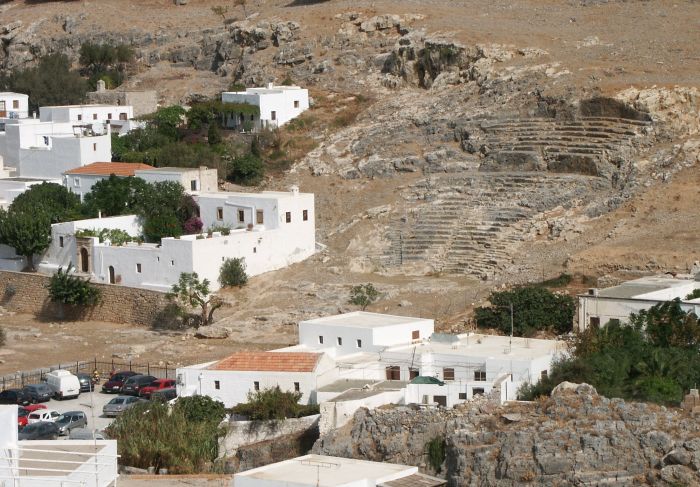
| Ancient amphitheatre at Lindos |


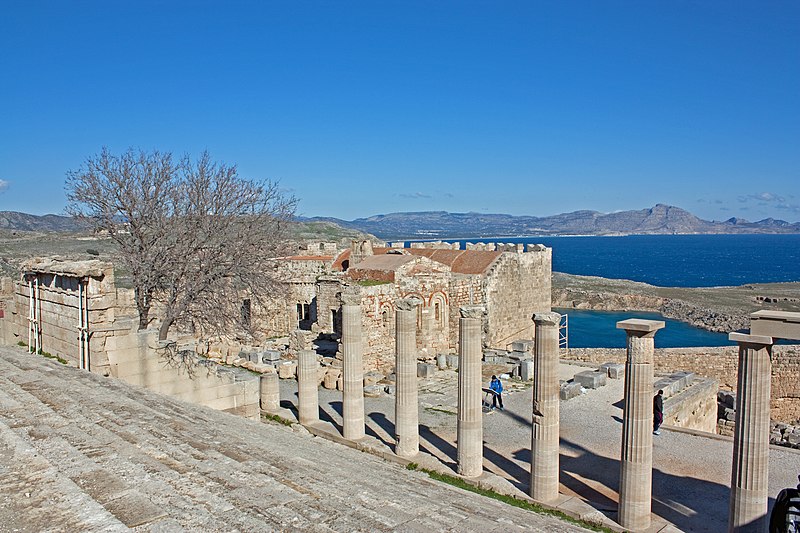


Acropolis of Lindos: the restored stoa
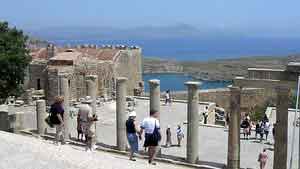
Above the modern town rises the acropolis of Lindos, a natural citadel which was fortified successively by the Greeks, the Romans, the Byzantines, the Knights of St John and the Ottomans. This makes the site difficult to excavate and interpret archaeologically. The acropolis offers spectacular views of the surrounding harbours and coastline.
History
Lindos was founded by the Dorian Greeks who arrived in about the 10th century BC. It was one of six Dorian cities in the area known as the Dorian Hexapolis. The eastern location of Rhodes made it a natural meeting place between the Greeks and the Phoenicians, and by the 8th century Lindos was a major trading centre. Its importance declined after the foundation of the city of Rhodes in the late 5th century.
In classical times the acropolis of Lindos was dominated by the massive temple of Athena Lindia, which attained its final form in around 300 BC. In Hellenistic and Roman times the temple precinct grew as more buildings were added. In early mediaeval times these buildings fell into disuse, and in the 14th century they were partly overlaid by a massive fortress built on the acropolis by the Knights of St John to defend the island against the Ottomans.
On the acropolis


Reconstruction of the Stoa
On the acropolis of Lindos today parts of the following buildings may still be seen:
The Doric Temple of Athena Lindia, dating from about 300 BC, built on the site of an earlier temple. Inside the temple is the table of offerings and the base of the cult statue of Athena.
The Propylaea of the Sanctuary, also dating from the 4th century BC. A monumental staircase leads to a D-shaped stoa and a wall with five door openings.
The Hellenistic stoa with lateral projecting wings, dating from aboput 200 BC. The stoa is 87 metres long and consisted of 42 columns.
The famous relief of a Rhodian trireme (warship) cut into the rock at the foot of the steps leading to the acropolis. On the bow stood a statue of General Hagesander, the work of the sculptor Pythokritos, who also carved the Winged Victory of Samothrace. The relief dates from about 180 BC.
The Hellenistic staircase (2nd century BC) leading to the main archaeological area of the acropolis.
Remains of a Roman Temple, possibly dedicated to the Emperor Diocletian and dating from about 300 AD.
The Acropolis is surrounded by a Hellenistic wall contemporary with the Propylaea and the stairway leading to the entrance to the site. A Roman inscription says that the wall and square towers were repaired at the expense of P Aelius Hagetor, the priest of Athena in the 2nd century AD.
The Castle of the Knights of St John, built some time before 1317 on the foundations of older Byzantine fortifications. The walls and towers follow the natural conformation of the cliff. A pentagonal tower on the south side commanded the harbour, the settlement and the road from the south of the island. There was a large round tower on the east facing the sea and two more, one round and the other on a corner, on the northeast side of the enceinte. Today one of the towers at the southwest corner and one to the west survive.The Greek Orthodox Church of St John, dating from the 13th or 14th century and built on the ruins of a previous church, which may have been built as early as the 6th century.
Excavations
Excavations were carried out at Lindos in the years 1900 to 1914 by the Carlsberg Institute of Denmark, directed by K F Kinch and Christian Blinkenberg. The acropolis site was excavated down to bedrock and the foundations of all the buildings were uncovered.
During the Italian occupation of the island (1912 to 1945) major "restoration" work was carried out on the Lindos acropolis, of a kind which modern archaeologists do not approve of. The north-east side of the Temple of Athena was restored. The monumental staircase to the propylaea was rebuilt and many of the columns of the Hellenistic stoa were re-erected. Large surfaces were covered with concrete. Bases and inscribed blocks were taken from their locations and placed along the restored walls.
Much of this work was done without taking into account the excavation evidence and without due care for the surviving architectural remains. In recent years Greek and international archaeologists under the supervision of the Greek Ministry of Culture have been working to restore and protect the ancient buildings on the acropolis, but this is made difficult by the increasing volume of tourist traffic.









See
The main attraction of Lindos is the town itself, winding paths between small traditional whitewashed buildings. Be brave and leave the main streets and explore the backstreets! Free maps can be picked up from the tourist information centre. These are obviously incredibly useful, but for some reason the map is without street names, and so it's still very easy to get lost.
Dotted around Lindos you will stumble across many Captain's Houses. These date from the 1400s and are particularly attractive. Double points if you can enter them as well as find them!
Visit the ruins of the Acropolis and the (still unfinished as of mid-2009) reconstructed temple of Lindian Athena. Entrance fee to the Acropolis itself is €6, but you do have a nice view from there. It's open till 6:40PM from March to December. There is also the remains of an Ancient Amphitheatre carved into the slope of the Acropolis. If you wish to avoid the tiring climb you can hire a donkey at the entrance of the town. Walking up the road that leads high up to the acropolis, the first ruins you will encounter are the medieval walls. In the early 14th century the Crusaders built fortifications upon the remains of earlier defenses, from both the Byzantine era and more ancient times. There are a few towers along the medieval walls which follow the natural contours of the high ground.
Kleoboulous's tomb. A small stone structure at the tip of the bay edit
The Church of the Assumption is worth sticking your head inside. It's by far the coolest place to suit down in Lindos and is covered in traditionally ornate icons and decoration. Free entrance.
You can also see St Paul's Bay where the saint supposedly crashed on the island and brought Christianity with him.
Do
Lindos has some of the few sandy beaches on Rhodes, but these beaches are easily crowded. Unfortunately, sometimes there is rubbish and litter such as cigarette butts to be seen. The bay has a lot of boats many of them serving the tourism industry and including a glass bottom boat.
Main beach, (Follow the path down from the Main square in Lindos).
St Paul's beach. Good beach near Lindos . Gets the shade from 5.30-6ish on southern side. Good swimming. Impressive location. €8 for a parasol and two sun loungers.
Eat
Lindos has many restaurants and tavernas, but as they all cater to tourists, the food can be disappointingly similar and un-Greek. There is food from every nationality you can think of. All staff are English speaking and menus are written in English. Most bars serve breakfast up until mid-afternoon so there is plenty of variety and choice.
Supermarkets stock a reasonable range of foods and lots of imported English food. There are three supermarkets within 100m of each other on the main street in Lindos. They're all more or less the same, offering more our less the same products at more or less the sane prices. They do have a good supply of seasonal fruit and veg, and they have a disproportionately large amount of alcohol and expensive prices. But, as there's not much else what are you going to do?
There are two more supermarkets up on Kranos Square (where the buses arrive.) Floras with the bigger selection, and Acropolis with the better fruit and veg. However, because they're well located to serve those waiting for coaches, prices are cranked up accordingly and they are thus more expensive than those down in the village itself.
In terms of convenience food, dotted around there are several souvlaki joints (serving Greek kebabs) and crepe houses serving both sweet and savory crepes - made fresh before your eyes - at very reasonable prices.
For souvlaki, expect to pay around €2.50 for a pitta gyro or kalamaki (chicken on a stick in a pitta.) Particularly tasty id Obelistiris on the main street. The owner was grumpy, but the gyros was good quality and fresh. Ask for 'ap ola' and you'll get tomato, onion, lettuce, tzatziki and chips inside.
Artemis, Pefkos, ☎ 0030 2244048365, Local cuisine prepared with the highest standards, friendly atmosphere and professional stuff.
Acropolis. All the food on the menu is barbecued and tastes delicious, using local meat from Rhodes.
Maria's Taverna.
Med East. The food is excellent, very Mediterranean. The ambience is very laid back, and the views of the acropolis are stunning.
Zorba's. Top quality fresh local produce. Open air restaurant and fantastic, friendly staff. Around.
Lindos has some of the few sandy beaches on Rhodes, but these beaches are easily crowded. Unfortunately, sometimes there is rubbish and litter such as cigarette butts to be seen. The bay has a lot of boats many of them serving the tourism industry and including a glass bottom boat.
Main beach, (Follow the path down from the Main square in Lindos).
St Paul's beach. Good beach near Lindos . Gets the shade from 5.30-6ish on southern side. Good swimming. Impressive location. €8 for a parasol and two sun loungers.
Eat
Lindos has many restaurants and tavernas, but as they all cater to tourists, the food can be disappointingly similar and un-Greek. There is food from every nationality you can think of. All staff are English speaking and menus are written in English. Most bars serve breakfast up until mid-afternoon so there is plenty of variety and choice.
Supermarkets stock a reasonable range of foods and lots of imported English food. There are three supermarkets within 100m of each other on the main street in Lindos. They're all more or less the same, offering more our less the same products at more or less the sane prices. They do have a good supply of seasonal fruit and veg, and they have a disproportionately large amount of alcohol and expensive prices. But, as there's not much else what are you going to do?
There are two more supermarkets up on Kranos Square (where the buses arrive.) Floras with the bigger selection, and Acropolis with the better fruit and veg. However, because they're well located to serve those waiting for coaches, prices are cranked up accordingly and they are thus more expensive than those down in the village itself.
In terms of convenience food, dotted around there are several souvlaki joints (serving Greek kebabs) and crepe houses serving both sweet and savory crepes - made fresh before your eyes - at very reasonable prices.
For souvlaki, expect to pay around €2.50 for a pitta gyro or kalamaki (chicken on a stick in a pitta.) Particularly tasty id Obelistiris on the main street. The owner was grumpy, but the gyros was good quality and fresh. Ask for 'ap ola' and you'll get tomato, onion, lettuce, tzatziki and chips inside.
Artemis, Pefkos, ☎ 0030 2244048365, Local cuisine prepared with the highest standards, friendly atmosphere and professional stuff.
Acropolis. All the food on the menu is barbecued and tastes delicious, using local meat from Rhodes.
Maria's Taverna.
Med East. The food is excellent, very Mediterranean. The ambience is very laid back, and the views of the acropolis are stunning.
Zorba's. Top quality fresh local produce. Open air restaurant and fantastic, friendly staff. Around.
Drink
Lindos has a wealth of different bars catering to all tastes. Many have rooftop gardens where you can watch the sun go down (or come up!) as you drink.Lindos By Night Bar especially has several roof gardens where you can watch the night go by. All bars are welcoming to children and there are many who have restaurants also. There are two nightclubs within the village itself and an open air club which can be accessed by a short taxi ride and which stays open until the very early hours of the morning.
Courtyard Bar. As the name suggests has a courtyard and a very smart clean interior with 2 open floors giving splendid views of the Acropolis. This is the only bar in Lindos to have live bouzouki music, this is provided on Sunday nights.
Yanni's. Fairly standard bar in Lindos. Coffee will set you back about €3.
Melia Cafe and Bakery, On St Stefanos square. Good bakery and cafe, but with a very nice roof top seating area. From here there are great views up to the Acropolis, across the Lindian rooftops, and there's a bit of a view down to St Paul's Bay. Melia's is off the well trodden tourist trail (a definite bonus) which means it's far quieter than the more central bars. Coffee costs €3.30.
Sleep
There are a large number of studios, apartments and villas - most with spectacular views - and all very close to the centre of town. You are best to get self-catering accommodation within the village itself for the best experience of Lindos as some of the Lindos hotels are located outside of the village meaning that you will need transportation to get you to the beach, restaurants and nightlife.
Eugenia villa and studio, Lindos, ☎ +30 2244031397, . The Eugenia Villa and Studio are next to each other, located above the Small Beach (known as the Pallas) in Lindos.
Lindos Blu Hotel, Lindos, ☎ +30 22440 321110 (info@lindosblu.gr, fax: +30 22440 32111), . checkin: 24 hr. Double €200-660.
Lindos Mare Hotel, Lindos, ☎ +30 22440 31130 (info@lindosmare.gr, fax: +30 22440 31131),. checkin: 24 hr. Double €220-260.
Lindos Villa, ☎ +44 1234 823 274,
Pefkos Beach Hotel. It is self catering but, very good, clean, and very friendly
Pefkos Garden Hotel, Pefki, ☎ +30 22440 48259 (info@pefkosgarden.gr, fax: +30 2244048228),checkin: 14:00; checkout: 12:00. Pefkos Garden is a comfortable and quiet hotel outside Rhodes near Lindos and Lardos.
Lindos has a wealth of different bars catering to all tastes. Many have rooftop gardens where you can watch the sun go down (or come up!) as you drink.Lindos By Night Bar especially has several roof gardens where you can watch the night go by. All bars are welcoming to children and there are many who have restaurants also. There are two nightclubs within the village itself and an open air club which can be accessed by a short taxi ride and which stays open until the very early hours of the morning.
Courtyard Bar. As the name suggests has a courtyard and a very smart clean interior with 2 open floors giving splendid views of the Acropolis. This is the only bar in Lindos to have live bouzouki music, this is provided on Sunday nights.
Yanni's. Fairly standard bar in Lindos. Coffee will set you back about €3.
Melia Cafe and Bakery, On St Stefanos square. Good bakery and cafe, but with a very nice roof top seating area. From here there are great views up to the Acropolis, across the Lindian rooftops, and there's a bit of a view down to St Paul's Bay. Melia's is off the well trodden tourist trail (a definite bonus) which means it's far quieter than the more central bars. Coffee costs €3.30.
Sleep
There are a large number of studios, apartments and villas - most with spectacular views - and all very close to the centre of town. You are best to get self-catering accommodation within the village itself for the best experience of Lindos as some of the Lindos hotels are located outside of the village meaning that you will need transportation to get you to the beach, restaurants and nightlife.
Eugenia villa and studio, Lindos, ☎ +30 2244031397, . The Eugenia Villa and Studio are next to each other, located above the Small Beach (known as the Pallas) in Lindos.
Lindos Blu Hotel, Lindos, ☎ +30 22440 321110 (info@lindosblu.gr, fax: +30 22440 32111), . checkin: 24 hr. Double €200-660.
Lindos Mare Hotel, Lindos, ☎ +30 22440 31130 (info@lindosmare.gr, fax: +30 22440 31131),. checkin: 24 hr. Double €220-260.
Lindos Villa, ☎ +44 1234 823 274,
Pefkos Beach Hotel. It is self catering but, very good, clean, and very friendly
Pefkos Garden Hotel, Pefki, ☎ +30 22440 48259 (info@pefkosgarden.gr, fax: +30 2244048228),checkin: 14:00; checkout: 12:00. Pefkos Garden is a comfortable and quiet hotel outside Rhodes near Lindos and Lardos.
Contact
There is an Internet cafe in Lindos called Lindianet
Get out
Frequent buses run from Rhodes city all up and down the east coast of the island, including to and from Lindos, though they can be slow because of frequent stops. For drivers, the road between Lindos and Rhodes city is a modern highway.
Afandou - One of the big villages on the island. The golf course of Rhodes is situated in this area along with a long beach
Kalathos
Stegna
Malona
Faliraki This is Rhodes' action resort. Go there to party. Nice beaches, not as windy as on the west coast and served by good public transport. Hotels near the water park are family friendly and not so popular with the 'clubbers'.
Rhodes Old Town The biggest city on the island and seat of the local government, also the oldest inhabited medieval town in Europe.
 The Ancient Stadium, built in the 2nd century BC, is located south of the hill of the Ancient Acropoles of Rhodes. Its current form is the result of restoration and it includes part of the shuttles (210 m. long, 35 m. wide). In the surrounding area, excavations have cast light upon invaluable findings, now exhibited in the Archaeological Museum of Rhodes. In the summer, the Stadium hosts plays and cultural events.
The Ancient Stadium, built in the 2nd century BC, is located south of the hill of the Ancient Acropoles of Rhodes. Its current form is the result of restoration and it includes part of the shuttles (210 m. long, 35 m. wide). In the surrounding area, excavations have cast light upon invaluable findings, now exhibited in the Archaeological Museum of Rhodes. In the summer, the Stadium hosts plays and cultural events.





There is an Internet cafe in Lindos called Lindianet
Get out
Frequent buses run from Rhodes city all up and down the east coast of the island, including to and from Lindos, though they can be slow because of frequent stops. For drivers, the road between Lindos and Rhodes city is a modern highway.
Afandou - One of the big villages on the island. The golf course of Rhodes is situated in this area along with a long beach
Kalathos
Stegna
Malona
Faliraki This is Rhodes' action resort. Go there to party. Nice beaches, not as windy as on the west coast and served by good public transport. Hotels near the water park are family friendly and not so popular with the 'clubbers'.
Rhodes Old Town The biggest city on the island and seat of the local government, also the oldest inhabited medieval town in Europe.






Ancient Theater







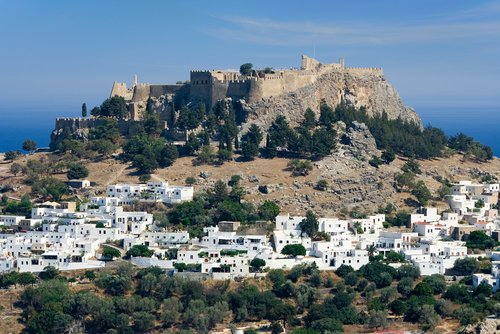



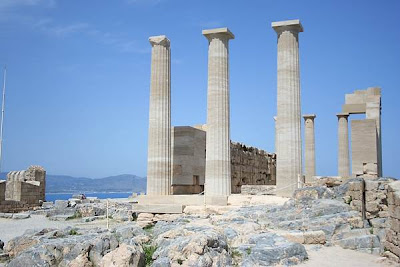

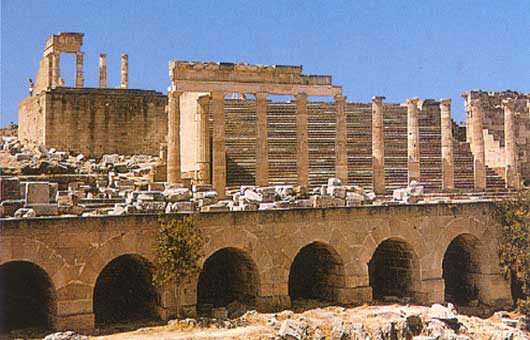
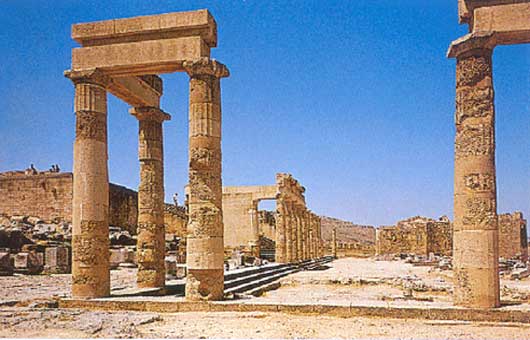
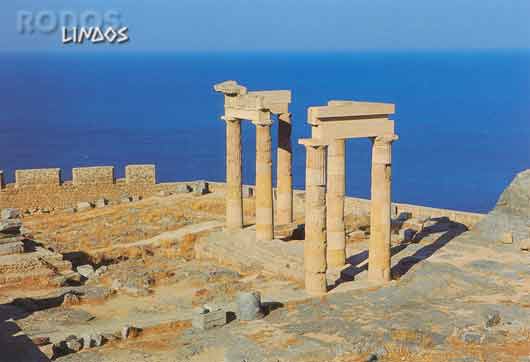
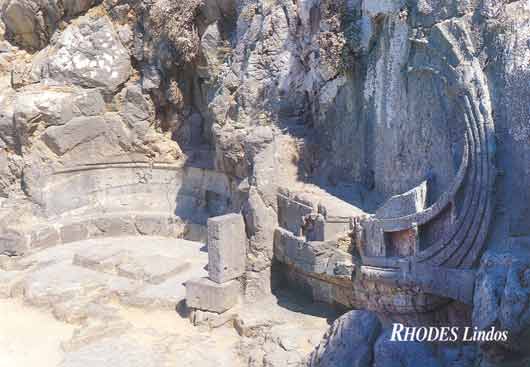
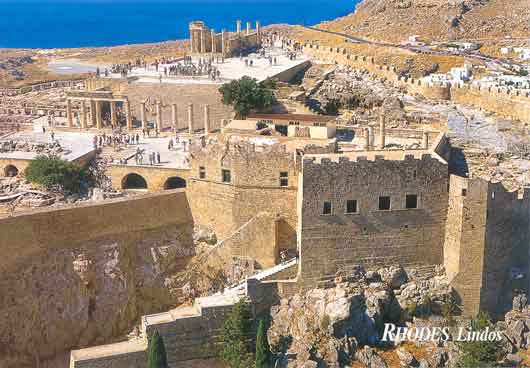
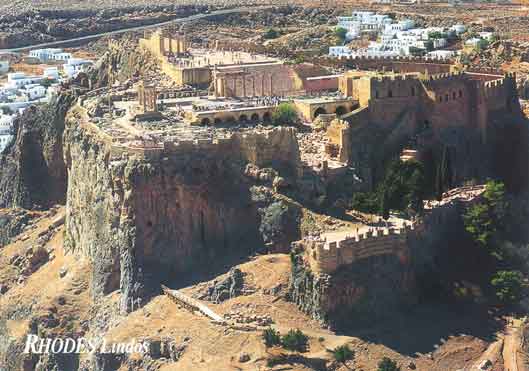
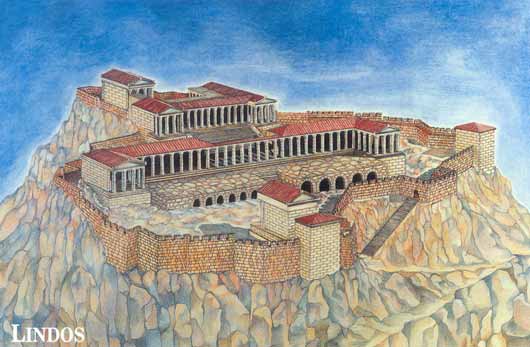
Δεν υπάρχουν σχόλια:
Δημοσίευση σχολίου